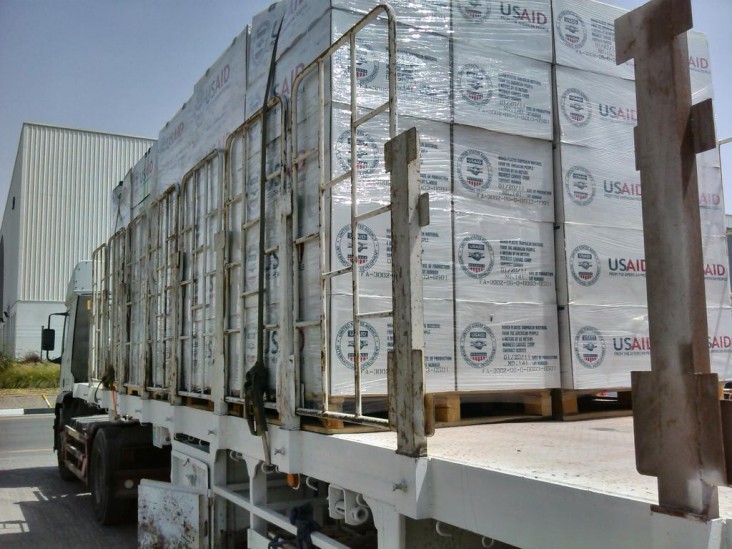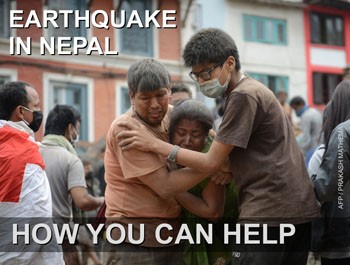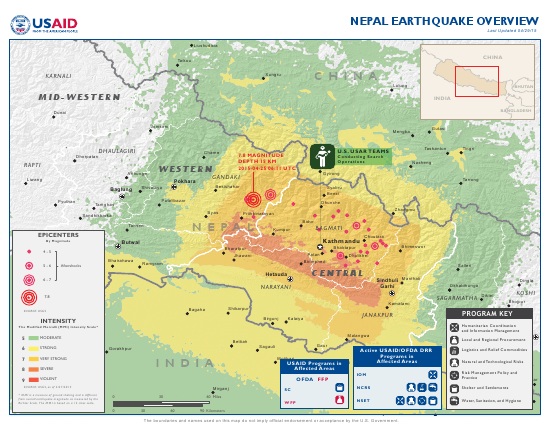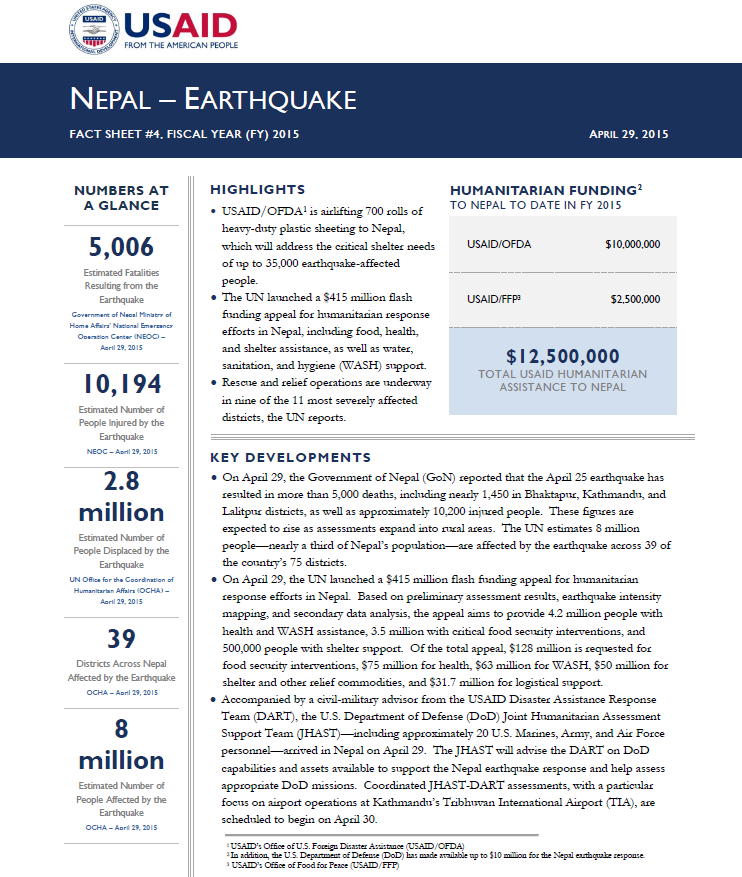Speeches Shim
April 29, 2015
Highlights
USAID/OFDA is airlifting 700 rolls of heavy-duty plastic sheeting to Nepal, which will address the critical shelter needs of up to 35,000 earthquake-affected people.
The UN launched a $415 million flash funding appeal for humanitarian response efforts in Nepal, including food, health, and shelter assistance, as well as water, sanitation, and hygiene (WASH) support.
Rescue and relief operations are underway in nine of the 11 most severely affected districts, the UN reports.
Key Developments
Nepal Earthquake Map - April 29, 2015 ![]() (pdf - 1 MB)
(pdf - 1 MB)
Numbers At A Glance
5,006
10,194
2.8 million
39
8 million
Humanitarian Funding:
To Nepal To Date In FY2015:
| USAID/OFDA | $10,000,000 |
| USAID/FFP | $2,500,000 |
| TOTAL | $12,500,000 |
In addition, the U.S. Department of Defense (DoD) has made available up to $10 million for the Nepal earthquake response.
Nepal Earthquake Fact Sheet #4 - 04-29-2015 ![]() (pdf - 188k)
(pdf - 188k)
On April 29, the Government of Nepal (GoN) reported that the April 25 earthquake has resulted in more than 5,000 deaths, including nearly 1,450 in Bhaktapur, Kathmandu, and Lalitpur districts, as well as approximately 10,200 injured people. These figures are expected to rise as assessments expand into rural areas. The UN estimates 8 million people—nearly a third of Nepal’s population—are affected by the earthquake across 39 of the country’s 75 districts.
On April 29, the UN launched a $415 million flash funding appeal for humanitarian response efforts in Nepal. Based on preliminary assessment results, earthquake intensity mapping, and secondary data analysis, the appeal aims to provide 4.2 million people with health and WASH assistance, 3.5 million with critical food security interventions, and 500,000 people with shelter support. Of the total appeal, $128 million is requested for food security interventions, $75 million for health, $63 million for WASH, $50 million for shelter and other relief commodities, and $31.7 million for logistical support.
Accompanied by a civil-military advisor from the USAID Disaster Assistance Response Team (DART), the U.S. Department of Defense (DoD) Joint Humanitarian Assessment Support Team (JHAST)—including approximately 20 U.S. Marines, Army, and Air Force personnel—arrived in Nepal on April 29. The JHAST will advise the DART on DoD capabilities and assets available to support the Nepal earthquake response and help assess appropriate DoD missions. Coordinated JHAST-DART assessments, with a particular focus on airport operations at Kathmandu’s Tribhuvan International Airport (TIA), are scheduled to begin on April 30.
USAR AND LOGISTICS
Damaged infrastructure, poor weather conditions, and landslides have hampered access into northern Gorkha District’s affected village development committees (VDCs)—small administrative divisions—which are presently accessible only by helicopter, according to relief actors. On April 28, local authorities dispatched two helicopters to northern Gorkha to conduct relief activities and distribute assistance.
The two U.S. urban search-and-rescue teams (USARs)—part of USAID’s 129-person DART—are coordinating searchand- rescue efforts with the GoN and other international USAR teams. On April 29, the U.S. teams completed search operations in northern Kathmandu and outskirts of the city.
On April 29, DART logistics officers visited the humanitarian staging area at TIA. Inaugurated by the Logistics Cluster in late March, the staging area serves as a hub for airlifted and overland humanitarian assistance entering the Kathmandu Valley in the event of an emergency. The UN World Food Program (WFP) has 32 mobile storage units (MSUs) in Nepal, including three MSUs at the humanitarian staging area, for warehousing needs.
SHELTER
Based on preliminary reports, the GoN estimates that the earthquake destroyed more than 70,000 houses in the worstaffected districts. Reports from the UN Office of the Resident Coordinator (ORC) and humanitarian actors indicate some damage to an additional 530,000 houses across the 39 affected districts, as well as to cultural heritage sites and other public infrastructure.
Assessments of earthquake damage and humanitarian needs are underway in Gorkha, where USAID partners and relief organizations report severe damage. Significant numbers of houses—up to 80 percent—as well as a number of schools are thought to have sustained damage, according to humanitarian organizations. According to the International Organization for Migration (IOM), 14 VDCs in Gorkha may have 90 percent of their structures destroyed; however, damages have not been confirmed in all locations.
On April 29, USAID/OFDA partner Save the Children (SC) reported reaching Gorkha’s northern VDCs via air transport facilitated by the Nepalese army. SC has distributed 204 household shelter kits purchased with USAID/OFDA funding from a previous fiscal year and pre-positioned in their Central Region warehouse. Each kit supports an average household of five people. SC also plans to distribute 1,800 tarpaulins for shelter repair.
To address critical shelter needs among earthquake-affected households, USAID/OFDA is airlifting 700 rolls of heavyduty plastic sheeting to benefit an estimated 7,000 households, or up to 35,000 people. USAID/OFDA partner IOM will distribute the plastic sheeting along with additional IOM supplies, such as rope, wire, and basic hand tools.
DISPLACEMENT

The UN reports that approximately 2.8 million people countrywide are displaced following the April 25 earthquake. Displaced populations in Kathmandu Valley are gathering in public spaces, including Kathmandu’s Halchowk Stadium, Memorial Park, and several recreational fields, as well as along roadsides. The GoN has identified 16 open spaces in Bakhtapur, Kathmandu, and Lalitpur districts for use as displacement sites for earthquake-affected populations that have lost their homes.
To track populations displaced by the earthquake and develop profiles of sites hosting internally displaced persons (IDPs), IOM is launching a displacement tracking matrix (DTM). The DTM will cover the 16 GoN-identified IDP camps in the Kathmandu Valley, beginning with those deemed highest priority based on size and site location.
With previous USAID/OFDA funding, IOM has worked with the GoN to identify, prepare, and preserve more than 80 open spaces in Kathmandu Valley, ensuring the sites are available for humanitarian purposes in the event of largescale disasters.
HEALTH
GoN Ministry of Health and Population (MoHP) officials reported that 11 earthquake-affected districts are in need of critical health support. The most urgent health-related needs include tents for use as shelter at overwhelmed or damaged hospitals and health centers, as well as logistics support.
The MoHP has deployed directors to each of the 11 districts to coordinate international medical teams. In addition, assessment teams led by senior MoHP officials, in coordination with UN World Health Organization (WHO) Surveillance Medical Officers, report that approximately 90 percent of health facilities outside primary cities are non-operational. MoHP has established field hospitals in Bhaktapur, Dhading, Gorkha, Lalitpur, and Kathmandu, and plans to expand to other districts as needed. The GoN is also conducting public health messaging to reduce the risk of disease outbreak.
FOOD SECURITY
The Food Security Cluster estimates that approximately 1.4 million people will require immediate food assistance across 12 districts during the next three months; rapid needs assessments are underway in each of these prioritized districts. The earthquake has disrupted preparations for the next planting season, which begins in June, and may affect food security and livelihoods in the coming months. An estimated 70 percent of Nepal’s population relies on agricultural production as their primary livelihoods.
WFP reports reaching northern Gorkha via helicopter on April 29 with food assistance for distribution through the Nepal Red Cross Society (NRCS). However, rains and subsequent landslides hampered distribution efforts, and the organizations were able to distribute only 100 metric tons (MT) of food.
WFP has launched a $116.6 million Corporate Response Emergency Operation (CR-EMOP) to meet the immediate needs of 1.4 million food-insecure people in Nepal’s Western and Central regions for three months. In support of WFP’s efforts, USAID’s Office of Food for Peace (USAID/FFP) has contributed $2.5 million to this EMOP for the purchase of 1,390 MT of rice. This amount is expected to benefit 120,000 people for one month.
CONTEXT
On April 25, a magnitude 7.8 earthquake struck central Nepal at a shallow depth of approximately 15 kilometers (km), according to the USGS. The epicenter of the earthquake was located approximately 77 km northwest of Kathmandu, the country’s capital city, and 73 km east of Pokhara, another major city in central Nepal.
The USG immediately issued a disaster declaration for Nepal due to the effects of the earthquake. Within hours of the seismic event, USAID/OFDA had activated a RMT in Washington, D.C., and deployed a DART—including USAR specialists—to support emergency response efforts in Nepal.
For nearly two decades, USAID/OFDA has supported disaster risk reduction (DRR) efforts in Nepal, including throughout Kathmandu Valley. USAID/OFDA funding has enabled the International Organization for Migration (IOM) to identify, prepare, and preserve more than 80 open spaces in Kathmandu Valley to ensure the sites are available for humanitarian purposes—such as distribution centers or warehouses—in the event of large-scale disasters. USAID/OFDA has also supported NRCS to pre-position critical emergency relief supplies in order to address the immediate needs of affected communities following a disaster.
Through the Kathmandu-based National Society for Earthquake Technology (NSET), USAID/OFDA is strengthening Nepal’s earthquake response capacity by institutionalizing DRR at the local and national levels in collaboration with the GoN, non-governmental organizations, schools, and local communities. With USAID/OFDA support, NSET is also promoting public-private partnerships for earthquake risk management and enhancing the capacity of municipal governments to develop and administer building code permits and control systems to better protect against seismic activity.
PUBLIC DONATION INFORMATION
The most effective way people can assist relief efforts is by making cash contributions to humanitarian organizations that are conducting relief operations. A list of humanitarian organizations that are accepting cash donations for disaster responses around the world can be found at www.interaction.org.
USAID encourages cash donations because they allow aid professionals to procure the exact items needed (often in the affected region); reduce the burden on scarce resources (such as transportation routes, staff time, and warehouse space); can be transferred very quickly and without transportation costs; support the economy of the disaster-stricken region; and ensure culturally, dietary, and environmentally appropriate assistance.
More information can be found at:
- The Center for International Disaster Information: www.cidi.org or +1.202.821.1999.
-
Information on relief activities of the humanitarian community can be found at www.reliefweb.int.




Comment
Make a general inquiry or suggest an improvement.